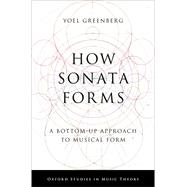How Sonata Forms A Bottom-Up Approach to Musical Form
, by Greenberg, Yoel- ISBN: 9780197526286 | 0197526284
- Cover: Hardcover
- Copyright: 6/10/2022
Traditional approaches to musical form have always adopted a top-down perspective whereby a work's form organizes and unifies the individual parts of the work through an overarching logic. How Sonata Forms turns this view on its head, proposing instead that it was the parts that conditioned and enabled the whole. Relying on a corpus of over a thousand works, author Yoel Greenberg illustrates how the elements of sonata form arose independently of one another, with an overarching idea of form only emerging at the tail end of its formative period during the eighteenth century.
Appreciation of the bottom-up nature of sonata form's evolution reveals it not as a stable package of features that all serve a common aesthetic or formal goal, but rather as an unstable collection of disparate and sometimes even contradictory common practices. The resolution of these contradictions presents a challenge to composers, rendering form a creative catalyst in itself, rather than as a compositional convenience. More generally, the deeply diachronic perspective of How Sonata Forms offers an alternative to the traditional synchronic outlook that pervades music theory in general and the study of form in particular. Rather than focus on definitions and taxonomies, How Sonata Forms proposes a focus on the motion of the system of form as a whole, suggesting that it is often more productive to appreciate the dynamics of a system than it is to rigorously define its parts.
Appreciation of the bottom-up nature of sonata form's evolution reveals it not as a stable package of features that all serve a common aesthetic or formal goal, but rather as an unstable collection of disparate and sometimes even contradictory common practices. The resolution of these contradictions presents a challenge to composers, rendering form a creative catalyst in itself, rather than as a compositional convenience. More generally, the deeply diachronic perspective of How Sonata Forms offers an alternative to the traditional synchronic outlook that pervades music theory in general and the study of form in particular. Rather than focus on definitions and taxonomies, How Sonata Forms proposes a focus on the motion of the system of form as a whole, suggesting that it is often more productive to appreciate the dynamics of a system than it is to rigorously define its parts.







